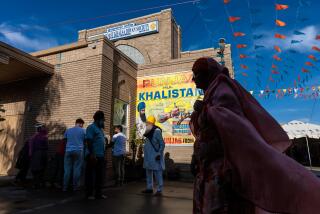Carolina city has a date with digital TV history
The future of broadcast television is set to premiere in this quaint seaside city next week. And the federal government is working hard -- too hard, some say -- to make sure it’s a hit here.
At noon on Monday, Wilmington’s five commercial broadcast stations are scheduled to become the nation’s first to permanently switch to all-digital signals, serving as a test of the government-mandated transition that other stations across the country will make in February.
“It’s like landing on the moon,” said Constance Henley Knox, general manager of CBS affiliate WILM. “We’re making history.”
The change is the biggest for over-the-air television since the advent of color 50 years ago. The more efficient signals, which many stations already are transmitting, provide a much clearer picture and allow broadcasters to offer four or more programs at the same time on new sub-channels.
But the end of analog broadcasts could leave many viewers who depend on rabbit ears and other antennas seeing nothing but static unless they upgrade their equipment. That’s because older sets can’t pick up the digital signals. Although most people who get TV from cable, satellite or phone companies will be unaffected, viewers who rely on antennas need a digital TV or a special converter box.
So for the last four months, the Federal Communications Commission has lavished disproportionate attention on Wilmington, the nation’s 135th-largest media market with 180,000 TV-watching households, to eliminate any chance the test run will flop.
A dozen FCC staffers have spent the summer crisscrossing the region like tourists to raise public awareness. They’ve visited the Poplar Grove Plantation farmers market and the Pender County Blueberry Festival. They’ve been to the 30th anniversary party for the public library in Elizabethtown and made friends at the Mae Coffee Shop in Whiteville. FCC Chairman Kevin J. Martin has visited five times to spread the word.
By all accounts the region is ready after the unprecedented FCC effort, which supplemented an aggressive publicity campaign by broadcasters. In a recent survey of Wilmington-area residents by the National Assn. of Broadcasters, 77% of respondents knew when the switch was occurring.
“I don’t think I’ve run into anybody who doesn’t know about it,” Louis Pillarella, a 68-year-old engineer from Wilmington, said last week during a digital TV expo where Martin and three FCC staffers answered questions.
But the all-out federal effort is a major reason a successful test of what one Wilmington station has dubbed “the big switch” could turn out to be a big illusion.
“It’s great Wilmington has come forward and offered to be the canary in the coal mine,” said Joel Kelsey, a policy analyst with Consumers Union, the nonprofit publisher of Consumer Reports magazine. “But we have several concerns about just how good a canary Wilmington is going to be.”
One is that no other place will get the type of personal oversight that the FCC has showered on Wilmington. Other media markets will be visited by only a single FCC commissioner, accompanied by a few staffers, for a couple of days.
Another reason a successful test in Wilmington may not be indicative of success in the rest of the country: Only about 8% of the area’s homes rely on antennas, compared with 12% nationwide, according to Nielsen Co.
What’s more, its flat topography eliminates the problems some viewers in Los Angeles and other hilly areas could face trying to tune in to digital signals. Poor reception leads to frozen pictures or blank screens.
FCC Commissioner Michael J. Copps said he hoped a smooth transition in Wilmington wouldn’t trigger complacency in Washington.
“The worst thing would be if we all get in the airplane Sept. 8 and come home and say, ‘That’s that,’ ” said Copps, who proposed the test-market idea. “It’s still such a huge leap that we’re making. Even though we have this one little test, it still boggles my mind we’re going to pull the lever on everyone else in February.”
To free up more airwaves for public safety communications and wireless devices, the federal government mandated that all full-power TV stations permanently turn off their analog transmitters and broadcast only in digital by the end of the day Feb. 17.
The millions of people with older TV sets who receive signals via antennas will need converter boxes, which typically cost $40 to $70. The government is subsidizing them through $40 coupons.
Last year, a coalition made up of broadcasters and consumer and civil rights groups launched a nationwide public awareness effort. But some groups and members of Congress have criticized the federal government for not doing enough to assure an easy transition. The FCC sought a test market, and Wilmington’s broadcasters volunteered.
Martin said Wilmington needed extra resources because it was making the transition early, and he declared that the test was already paying dividends. After seeing the benefits of having staffers on the ground there, Martin announced last month that FCC commissioners would fan out to the 80 markets with the most over-the-air-only households, including Los Angeles, between now and February. They plan to hold town hall meetings and other events to raise awareness and answer questions about the transition.
“We’re going to be taking that same kind of effort, that same playbook, to the most at-risk markets,” Martin said.
But not to the same degree as in Wilmington, which Mayor Bill Saffo said received “the Cadillac version.”
At first, Saffo was apprehensive when broadcasters told him about the test, which comes in the middle of hurricane season. (In fact, the government might delay the test if Tropical Storm Hanna, which is headed toward the Carolinas, strengthens and hits Wilmington hard.)
“What happens if I wake up on Sept. 9 and I’ve got . . . 10,000 people without television?” Saffo recalls wondering. He pushed Martin for federal resources and last week described the FCC effort as “phenomenal.”
A dozen staffers have taken turns shuttling the nearly 400 miles from Washington so that one has been in each of the area’s five counties nearly daily since the test was announced. They’ve attended more than 300 events.
One of the biggest, a four-hour digital TV expo at the Coastline Conference and Event Center, was sponsored by NBC affiliate WECT. The first booth inside the door was staffed by three FCC representatives. Martin worked the room in a blue polo shirt bearing a digital-TV transition logo.
As they listened to a steel drum band, dozens of people entered raffles for converter boxes and wandered through the displays by local TV stations, electronics makers and cable and satellite providers.
Clarence Russ, 57, of Wilmington, saw public service announcements about the digital switch and came to find out how to get one of those boxes. An African American who lives on disability payments and uses a coat hanger for an antenna on his old analog set, Russ is the type of person whom civil rights groups and lawmakers worry could be left without TV.
Jill Pender, a senior attorney with the FCC’s consumer bureau, helped Russ. She used one of two laptop computers at the FCC booth to complete an online form for a coupon.
The government filled out the form for Russ. All he had to do was click the signature box.
--
jim.puzzanghera @latimes.com
--
(BEGIN TEXT OF INFOBOX)
Getting ready for the digital TV switch
All full-power television stations in the U.S. will cease transmitting analog signals by the end of the day Feb. 17, 2009, and begin broadcasting only in digital. Here’s what you need to do to prepare.
If you get your TV via cable, satellite or phone lines, you should be fine. Pay TV providers have promised to continue converting the digital signal to analog for people with older sets, although some customers might need to rent a set-top box. Check with your provider.
If you depend on an antenna or perhaps have an extra television that uses one, check to see whether your set has a digital tuner. Most TVs sold after early 2007 have one and can receive the new signals. If you bought your TV before 2004, it’s unlikely to have a digital tuner. You’ll need either a new digital set or a digital-to-analog converter box.
The federal government is offering each household two $40 coupons to buy basic converter boxes, which range in price from $40 to $70. You can apply for a coupon at www.dtv2009.gov or by calling 888-388-2009.
For more information about the transition go to www .dtv.gov. Read previous Times articles about the switch at www.latimes.com/digitaltv.
Source: Times research
More to Read
Start your day right
Sign up for Essential California for news, features and recommendations from the L.A. Times and beyond in your inbox six days a week.
You may occasionally receive promotional content from the Los Angeles Times.







